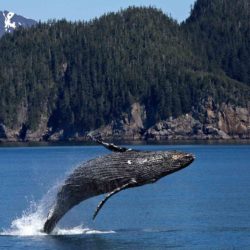Major changes announced for the Endangered Species Act

Image by Bonnie Coe
When the Endangered Species Act was signed into law in 1973, President Nixon had just been inaugurated for his second term in office and the average cost of gasoline was under 40 cents per gallon. Nearly fifty years later, gas prices aren’t all that’s changed. To stay relevant in our rapidly evolving world, the laws that govern our actions must also be periodically updated. Just how they should change is a matter of opinion, however, and is often indicative of the current administration’s moral and political predilections.
The Endangered Species Act (ESA) is no stranger to political controversy and has been the subject of particular scrutiny since its inception. The ESA can act as a roadblock, meaning it can stop development projects in their tracks with little recourse. This is understandably unpopular with developers, including the mining and fossil fuel industries, which rely heavily upon federal permits to excavate and extract from surface and subsurface habitats. If a proposed project site happens to be within the designated critical habitat of a threatened or endangered species, permits may be denied, costing applicants significant time, money, and resources. Conservative lawmakers have long advocated on behalf of affected parties, from individual ranchers to companies on the Fortune 500 list, in pursuit of less stringent regulatory protections. On Monday August 12, advocates for deregulation celebrated a major victory when the Department of the Interior’s U.S. Fish and Wildlife Service (USFWS) and the Department of Commerce’s National Marine Fisheries Service (NMFS) finalized substantial revisions that apply to the ESA.
Here’s some of what’s changing:
Economic impact can now be considered in species’ status determinations
One of the hallmarks of the ESA is that the cost of protecting a species cannot be considered in its status review. Therefore, a species cannot be down-listed or delisted for economic reasons. Monday’s updates have made it so an economic analysis can be included in the decision-making process, potentially overshadowing science-based justifications and undermining the scientific integrity of the ESA.
The “foreseeable future” may now exclude climate change
The ESA defines “threatened species” as “any species which is likely to become an endangered species within the foreseeable future throughout all or a significant portion of its range.” The statutory interpretation of ‘foreseeable future’ is therefore a critical metric in determining whether a species requires protection. The new construal of the term ‘foreseeable future’ could allow the agencies to limit the period under consideration to a time before climate change is likely to have an impact, discounting potentially significant threats to species’ survival. Read the text here.
Automatic protections for threatened species are removed
Previously, threatened species listed by the USFWS automatically received the same protections as the more imperiled endangered species upon listing unless otherwise specified. This so-called ‘blanket rule’ is now dissolved, bringing the USFWS in line with NMFS practices. Now, protections against harm and harassment for newly listed threatened species will be determined on a case-by-case basis. Read the text here.
Habitat protections are not guaranteed
Protecting threatened and endangered species has traditionally also involved protection of the resources they rely upon to survive. Designating critical habitat has been an integral step in the listing process, but it will no longer be required under the new regulations. Instead, the agency may now find that designating critical habitat is not prudent. Where prudent, critical habitat will be determined by the ‘efficiency’ of conservation in a given location, where ‘efficiency’ is heavily influenced by social and economic factors. Read the text here.
After the final revisions were announced, conservation groups around the country leapt into action to combat their implementation. Environmental advocacy groups like Earthjustice and the Center for Biological Diversity vehemently oppose the revisions, arguing that the changes will cripple the ESA and be disastrous for hundreds of animals and plants already in jeopardy of extinction. They also contend that the Endangered Species Act in its current form is remarkably successful and widely supported, and that the new revisions serve industry interests over the interests of the American people. Massachusetts has already announced its intentions to sue the federal government, with the office of the attorney general sharing its concerns that the changes will “pave the way for approval of oil and gas and other development projects despite any species impacts.”
Meanwhile, Republican lawmakers have applauded the announcement and many have vocalized their support, like North Dakota Senator Kevin Cramer: “[The revisions] will help achieve actual species recovery while providing much-needed clarity and stability to those who are too often held hostage by the ESA. I applaud Secretary Bernhardt and the Trump Administration for their continued work to make the federal government more efficient and effective, and I look forward to continue working with them to modernize the Fish and Wildlife Service.”
Political debates aside, the Endangered Species Act is a lifeline for imperiled species and has been over 99% effective at preventing extinction. Teatown is proud to support the ESA and the vital protections it has provided to species like the bald eagle, whose recovery we celebrate each year at EagleFest. Removing environmental defenses to encourage economy over ecology will accelerate the harmful effects of anthropomorphic climate change and is contrary to the spirit of scientific conservation.
Want to find out about proposed rules and other federal actions before they hit the news? Make the Federal Register at www.federalregister.gov a regular part of your internet routine.
Species that have benefited from the Endangered Species Act


Bald eagle (Haliaeetus leucocephalus)

Grizzly Bear (Ursus arctos horribilis)



American peregrine falcon (Falco peregrinus)
photo: Ron Knight/flickr.com (CC BY 2.0)

Steller sea lion (Eumetopias jubatus)
photo: NOAA

Island fox (Urocyon littoralis)
photo: USFWS

White-haired goldenrod (Solidago albopilosa)
Photo: John MacGregor, Kentucky Dept. of Fish and Wildlife Resources

About the Author
Nadya Hall
Nadya has her master’s in environmental policy with a focus on human-wildlife coexistence. She is passionate about the conservation of wildlife and wild places through science, advocacy, and environmental education.


